The Sephardic Jews, or Spanish Jews, have had a significant impact on the history and culture of Spain. They were one of the largest and most prosperous Jewish communities in the world, with a presence in Spain dating back to Roman times. During the peak of the Golden Age of Jewish Spain, Sephardic Jews played a vital role in the country's cultural and economic growth. They excelled in fields such as medicine, science, philosophy, and poetry, and their contributions to Spanish culture were immeasurable - these folks were the real deal! In fact, some of the most significant works of Spanish literature were written by Sephardic Jews (in Hebrew).
But, like all good stories, there's a dark side to this one. Despite their contributions to Spanish society, Sephardic Jews faced persecution and discrimination over the centuries. In the late 15th century, the Spanish Inquisition led to the forced conversion or expulsion of thousands of Sephardic Jews. Many fled to other countries, taking their culture and traditions with them.
But even today, the legacy of the Sephardic Jews can still be felt in Spain. Their impact on the country's culture and history is undeniable, and their experiences serve as a powerful reminder of the dangers of discrimination and the importance of cultural diversity and acceptance.
Here, we will present you the top cities to visit in Spain if you are a Jewish history buff!
Girona
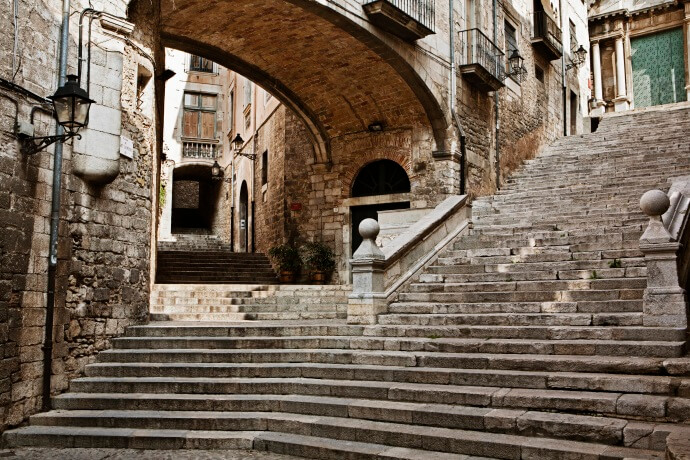
Did you know that the Jewish Quarter in Girona, a lovely city in the Catalonia region, was one of the largest and best-preserved Jewish quarters in Europe during the Middle Ages? By strolling through its narrow streets, you can still imagine the hustle and bustle of daily life of the Jewish community that lived in this quarter, also known as El Call. The term "call" actually comes from the Hebrew word kahal, which means "community".
The El Call quarter, situated within the medieval walls of the city, is characterized by its narrow streets, winding alleys, and stone buildings. During the Middle Ages, Girona was a thriving center of Jewish culture, and the community in El Call was an important intellectual and commercial hub. However, as happened in the rest of Spain, the Jewish population was expelled from Girona as part of the Spanish Inquisition.
The Jewish community in Girona had a significant impact on the development of Kabbalah, a mystical branch of Judaism. And fun fact: some even say that the famous Kabbalist Moses de Leon, who authored the Zohar (a fundamental text of Kabbalah), was from Girona! The truth is that Girona was home to many prominent Jewish scholars and mystics during the Middle Ages, and it was a center of Jewish learning and spirituality.
Today, El Call is a popular tourist destination, known for its rich background and cultural heritage of major significance. You can explore the labyrinthine of beautiful streets and alleys, visit the ancient synagogue, and learn all about the history of the Jewish community in Girona. The neighborhood also has a number of shops, restaurants, and museums that offer a glimpse into the local culture and cuisine.
The Museum of Jewish History in Girona, for example, is a must-visit if you are into Jewish culture. It's an interactive museum located in the heart of the Jewish Quarter that takes you on a journey through the history of the Jewish community in Girona. You'll learn about their customs, their way of life, and their contributions to the city, through artifacts, documents and interactive displays.
You can also stop by the Girona Cathedral - while not a specifically Jewish site, the Girona Cathedral has several features that attest to the city's Jewish history. The cathedral's Gothic nave is said to have been built with Jewish money, and there are several Hebrew inscriptions in the cathedral's cloister. Plus, it is a magnificent example of Gothic architecture! Also, the Jewish Cemetery, located just outside the city walls, is a poignant reminder of Girona's Jewish past, although it is not open to the public and is only accessible by appointment.
Girona's Jewish heritage is an excellent example of how different communities can coexist and contribute to a city's identity!
Besalu
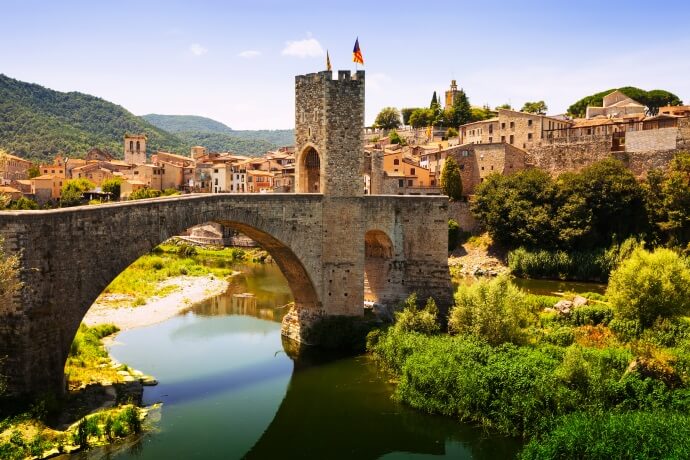
This small town in Catalonia may be tiny, but it's mighty when it comes to its Jewish history! Besalu was once home to a prosperous Jewish community during the Middle Ages, and remnants of their legacy can still be spotted today. The Jewish quarter of Besalu was located in the center of town, and it was a hub of activity during its heyday. The quarter was home to a synagogue, a mikveh, and a hospital, all of which have been preserved to this day. There are also several well-preserved medieval buildings that are worth a close look!
One of the most notable features of Besalu's Jewish heritage is indeed the Mikveh, which is a Jewish ritual bath. This Mikveh was discovered in the 1960s and has been meticulously restored to give visitors a glimpse into the past. Imagine what would be like to take a dip in a ritual bath that's centuries old!
The synagogue in the Jewish quarter is also a particularly remarkable site. It is one of the remaining examples of medieval Jewish architecture in Spain and is considered to be one of the most significant historical Jewish sites in the country. It dates back to the 12th century and is built in a Romanesque style. You can still see the original stone carvings and decorations on the walls!
Besalu is also home to a Jewish History Museum that provides you with an in-depth look at the history and culture of the Sephardic Jews in Catalonia. It contains artifacts, documents, and photographs that will allow you to dive into the past daily lives of the Jewish community in the city.
Be sure to pass by the Plaque of the Expulsion, located on a building in the town's main square. It commemorates the expulsion of Besalu's Jewish population in 1492, and is a reminder of the difficult history of Spain's Jewish community and the lasting impact of the Inquisition.
The Jewish community of Besalu may be long gone, but their legacy lives on in the town's architecture and culture. Today, visitors from all over the world come to explore its narrow streets and experience its unique charm. It's a testament to the enduring legacy of the Jewish people and their contributions to Spanish culture!
While in Besalu, be sure to also contemplate the medieval Besalu Bridge, one of the most iconic sights in town, and visit the ruins of the imposing castle.
Toledo
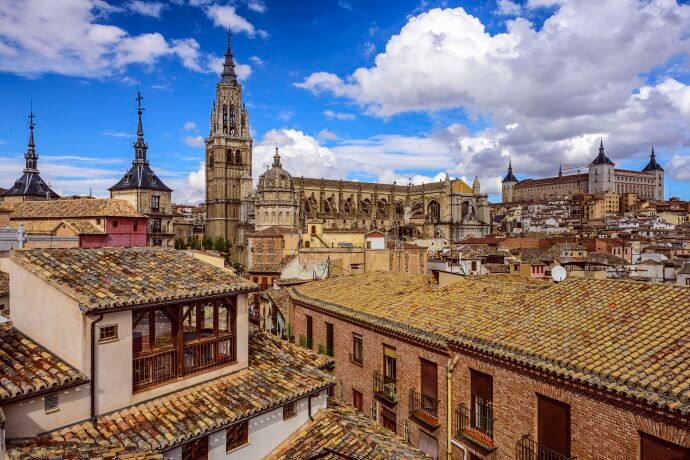
The Jewish community in Toledo dates back to the Roman era - talk about a long legacy! The Jewish quarter, known as Judería, was once a bustling center of commerce, culture, and intellectual activity. In fact, Toledo's Judería is one of the best-preserved Jewish quarters in Spain, and it's a must for anyone interested in Jewish heritage.
The Jewish community coexisted peacefully with the Christian and Muslim communities in Toledo for many years, and their influence on the city's culture and economy was significant. However, this peaceful coexistence came to an end in the late 14th century, when anti-Semitic sentiment began to spread throughout Spain. A wave of violent pogroms swept through Toledo and other Spanish cities, resulting in the deaths of many Jews and the forced conversion of many others. But despite these dark times, the Judería in Toledo remains a testament to the rich history and cultural heritage of Spain's Jewish community.
One of the most striking features of Toledo's Jewish heritage is the magnificent synagogue of Santa María La Blanca. This spectacular building, dating back to the 12th century, is a masterpiece of Mudéjar architecture and is one of the oldest synagogues in Europe. It's a true testament to the Jewish community's rich cultural and artistic legacy.
You can also visit the El Transito Synagogue and the Sephardic Museum - this 14th-century synagogue has been converted into a museum dedicated to the history and culture of Sephardic Jews in Spain. You can admire the synagogue's elaborate decoration, including a stunning plasterwork ceiling, and explore the exhibits showcasing Jewish life and tradition in medieval Toledo. It features intricate decorations with Mudéjar-style elements, as well as stunning geometric, floral, and inscriptions in both Arabic and Hebrew.
Toledo also has an interesting connection to one of the most famous Jewish philosophers, Moses Maimonides. Maimonides lived in Toledo for a time and was the personal physician of the city's Muslim ruler. He is also known for his influential philosophical works, including the Guide for the Perplexed.
Once in Toledo, take the opportunity to also explore the other important highlights in the city, such as the Alcázar of Toledo, an impressive fortress that sits atop a hill overlooking the city, the Gothic Cathedral, one of the most impressive in Spain, and the Monastery of San Juan de los Reyes, a beautiful monastery that was built in the late 15th century, with an impressive cloister and beautiful gardens.
Córdoba

It's easy to imagine the bustling markets, the sounds of children playing, and the aroma of spices and foods wafting through the air in Córdoba, in southern Spain, given it was once a thriving center of Jewish culture and learning. The Jewish quarter, known as Judería, is a maze of narrow streets and alleys that transport you back in time! It is located in the historic city center, close to the famous Mezquita-Catedral (Mosque-Cathedral), and it is characterized by its whitewashed houses and charming patios.
One of the highlights of Córdoba's Jewish heritage is the small but splendid and well-preserved synagogue, which dates back to the 14th century. This beautiful building is a true masterpiece of Mudéjar architecture, with intricate stucco work, horseshoe arches, and decorative tiles. Another interesting attraction in Córdoba's Jewish quarter is the Casa de Sefarad, a museum dedicated to the Sephardic Jewish culture, where you can learn about the history and traditions of the Jewish people who once lived in Córdoba, and take a peek into their daily lives.
In addition to the beautiful synagogue and the Casa de Sefarad, you can also contemplate the statue of Maimonides, who lived in Córdoba in the 12th century. The statue is located in the square that bears his name, and it's a tribute to his contributions to both Jewish and Western thought.
While strolling through the Jewish quarter, be sure to also stop by the Zoco Municipal Market, with a rich history. It was built on the site of the old Jewish market and is now a vibrant place where you can buy local products and crafts.
Other notable sites include the Plaza del Potro, a charming square with a Renaissance-era fountain, and the Calleja de las Flores, a picturesque alley lined with flowers and artisan shops.
Jaén
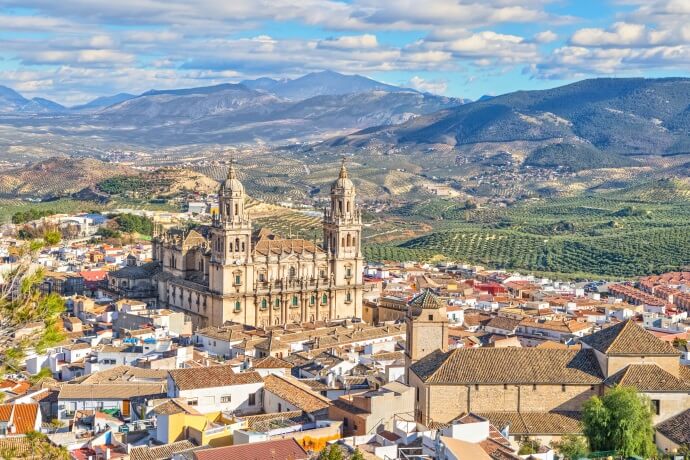
Jaén is a city in southern Spain that's often overlooked but definitely worth a visit. Historical records indicate that the Jewish community in Jaén had a significant presence and was known for its economic and intellectual activities, including textile production, commerce, and the study of the Torah, although the Jewish community in Jaén was relatively small compared to other cities in Spain.
While this community was expelled from Jaén in 1492 and the physical Jewish quarter no longer exists, there are still some traces of Jewish heritage in Jaén today. One of the most notable examples is the Santa Cruz neighborhood, close to the Santa Cruz church and the Jaén Cathedral, which was once a thriving Jewish quarter during the Middle Ages. Although the physical buildings from that period have been lost, the neighborhood still bears the names of many Jewish families who once lived there, and the area's history is reflected in its architecture, culture, and traditions.
This neighborhood is known for its quaint narrow streets and whitewashed houses, which are typical of Andalusian architecture. It is known for its vibrant cultural scene and is home to several historical landmarks, such as the Santa Cruz church, which was built in the 16th century and is considered one of the finest examples of the Renaissance style in Jaén.
One of the most fascinating aspects of Jaén's Jewish heritage is the story of Samuel HaLevi, a Jewish doctor who lived in the 12th century. He served as the personal physician to the Muslim ruler of Jaén, and his tomb is still a popular pilgrimage site for Jews and Muslims alike. It is located in the Jewish cemetery, which is now a municipal park called Parque de la Alameda, and is marked with a small monument.
The story of Samuel HaLevi, however, is just one example of the rich cultural and historical legacy of the Jewish community in Jaén, which played an important role in the city's development during the medieval period.
Barcelona
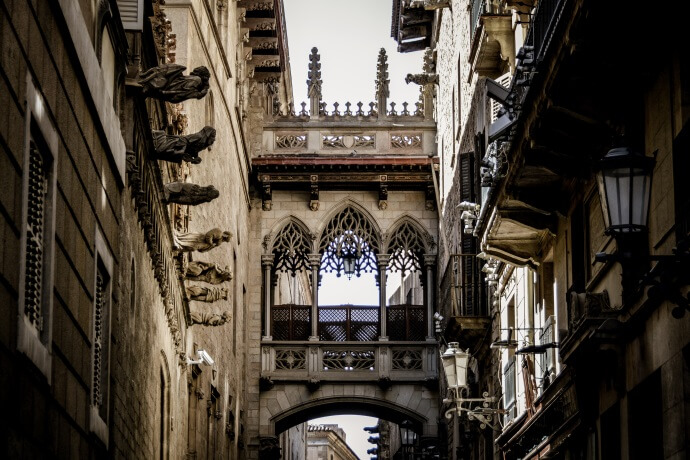
It looks like we have another hotspot for Jewish heritage in Spain - Barcelona! This cosmopolitan city has a rich history and culture, and the Jewish community has played a significant role in shaping it.
One of the most interesting places to visit in Barcelona is the Jewish Quarter, known as El Call. Here, you can walk through narrow alleys and admire medieval buildings that were once home to a thriving Jewish community. Located in the Gothic Quarter, it is a maze of narrow streets and alleys that have preserved the architecture of the Jewish community that lived there in the Middle Ages. Some of the highlights of the Jewish Quarter include the Carrer de Sant Domènec del Call, which was the main street of the Jewish community, and the remains of the Sinagoga Major, a 14th-century synagogue that was discovered in 1995 during excavations. Today, you can admire the intricate stonework, delicate arches, and other details that make the Sinagoga Major a unique and valuable piece of Barcelona's Jewish heritage.
You can also find a plaque dedicated to the memory of Rabbi Shlomo Ben Adret, a prominent Jewish leader who lived in Barcelona during the 13th century.
Another fascinating aspect of Barcelona's Jewish heritage is the role that Sephardic Jews played in the city's history. The Sephardic Museum in Barcelona is a must-visit attraction that showcases the culture and history of these Jews who lived in Spain for centuries. It features exhibits that highlight the customs, traditions, and daily life of the Sephardic Jews, including their religious practices, food, music, and language.
And if you're a foodie, you will definitely want to try some Sephardic cuisine while in Barcelona. From matzah ball soup to pastelitos de almendra (almond pastries), your taste buds will thank you for the experience.
Once in Barcelona, take the time to further explore the other important attractions as well, such as the Sagrada Familia, the Park Guell and Casa Batlló (three Gaudí’s masterpieces), and La Rambla, a famous street lined with shops, cafes, and street performers.



